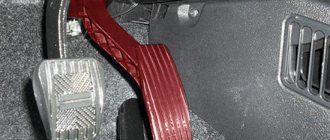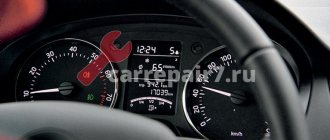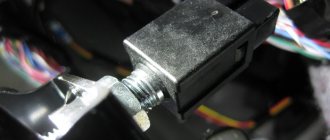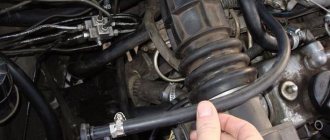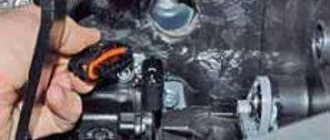January 11, 2018 Lada.Online 285 200 23
E-GAS or electronic gas pedal is installed on all Lada models (XRAY, Vesta, Largus, Granta, Kalina, Priora and Niva 4x4). Owner reviews about it are not reassuring; many complain that the e-gas pedal is “dumb” (less sensitive and informative than a conventional cable). Did you know that in some cases the electronic accelerator pedal can be adjusted to be more responsive and a little livelier?
We determine the model of the accelerator pedal; this can be done by the catalog number, which is glued to the side of the body. If you cannot access the sticker, you will have to remove the electronic gas pedal:
- Disconnect the block with wires next to the gas pedal;
- Unscrew three nuts using a 10mm wrench;
- Remove the housing and pedal assembly.
The manufacturer installs at least two types of electronic gas pedals on Lada cars (depending on the year of manufacture):
- Old model (catalog number: 11183-1108500);
- New sample (article: 11183-1108500-01).
Each block is modified differently. Attention! You do all further actions at your own peril and risk. In addition, you may lose your warranty.
Electronic gas pedal VAZ 2114: advantages of use and principle of operation
Since 2011, all cars produced by the AvtoVAZ concern are equipped with an electronic gas pedal, including VAZ 2114 models produced after 2011. The e-pedal has many advantages, but also due to the novelty of the mechanism used for AvtoVAZ, there were a number of shortcomings. Many motorists who bought a car with e-gas VAZ 2114 encountered problems after some time.
Model features
The US Department of Commerce has designated business accelerators
as incubator support institutes and incubation programs for investment-ready companies. The main focus of accelerators is technology, in particular software startups: the cost of launching and developing these companies has decreased significantly. The role of accelerators in venture financing is to select promising startups for funds and prepare teams to attract investment rounds.
In the absence of a generally accepted definition, the characteristic features of business accelerators allow us to draw a line between them and traditional incubators. Summarizing thesis from Jed Christensen's MBA thesis, "Copying Y Combinator"
(2009), research from The Startup Factories
authored by Paul Miller and Kirsten Bound (2011) and published by Susan Cohen in the journal
Innovations: Technology, Governance, Globalization
of the Massachusetts Institute of Technology (December 2013), key features of the model can be noted.
- The composition of accelerators is formed on a competitive basis. Teams go through a rigorous selection process, interviews, and interviews. The number of applications to well-known accelerators (such as Y Combinator) reaches thousands, but only a few dozen teams are accepted into one set.
- Qualifying teams are trained simultaneously as part of a stream (also called a roster, set, or cohort). Constant communication promotes the exchange of experiences and mutual support.
- Most accelerators provide seed funding to residents and receive income from the growth in the value of their shares in the capital of invested startups.
- Acceleration programs are limited to several months, during which teams undergo training in areas close to entrepreneurship, communicate with well-known entrepreneurs, investors and niche specialists, and work with mentors. The development of a business model plays a major role in the learning process. Upon completion of acceleration, teams present their projects to investors and have the opportunity to attract the next round of funding.
Mechanical and electronic pedal
But first, let’s talk about why it was necessary to remake an old, reliable system that works without interruptions. There are several reasons for this.
When controlling the throttle position directly with your foot using a cable, there is a slight delay between opening the valve and adjusting the mixture, this leads to the following consequences:
- the wrong mixture produces a large amount of C02;
- non-compliance with EURO-5 and EURO-4 standards;
- when the gas pedal was fully pressed, much more fuel was consumed than necessary, which increases the overall consumption;
- direct control of the mixture by a person leads to the possibility of operating the internal combustion engine in critical modes at high speeds or changing the mixture too sharply, which negatively affects the service life of the engine.
In order to avoid these problems, engineers decided to protect human access to direct control of engine operating modes; in the VAZ 2114 with e-gas, the throttle valve is controlled by the ECU, taking into account the position of the gas pedal, but not 100% subordinate to it.
- uniform opening of the throttle valve, without jerking;
- synchronous change in the composition of the mixture and opening of the damper;
- saving fuel and increasing engine life;
- possibility of installing anti-skid and traction control systems.
In theory, everything looks great and all the changes seem only for the better. But the electronic gas pedal of the VAZ 2114 has problems that appear because during production the device was not sufficiently tested and a crude product was released onto the market.
Advice
Today, all manufacturers are moving to electronic pedals in one way or another, and you shouldn’t refuse to buy a specific car just because its gas is not controlled by a cable. Just keep in mind that electronic throttle control will delay engine response. You must always keep this delay in mind and press or release the gas a little earlier than required (it is clear that this is not always possible). Only the car manufacturer can influence the delay time by changing the algorithms for operating the gas pedal, or by installing faster hardware in the engine control unit.
WE RECOMMEND ALSO READ:
E-gas VAZ 2114 problems
Often the main disadvantages of electronic gas are these aspects:
- Delay in the car's response to pressing the accelerator pedal.
- Problems with floating speed, gas sticking and self-actuating.
- Impossibility of quick car tuning.
The delay is formed due to the fact that the signal from the pedal is first transmitted to the ECU and only after processing, the electric drive on the damper begins to smoothly change its position. In newer cars, this delay has been reduced thanks to better software and faster hardware. The e-gas equipment of the VAZ 2114 can also be reflashed, increasing the power and pedal response speed, but lowering the environmental standard to EURO-2.
In early versions, motorists often encountered incorrect operation of the e-gas, the speed fluctuated, there might be no reaction to the gas at all, or there could be sudden jumps in engine speed. All this was the result of faulty wiring made by AvtoVAZ; if such faults occur, it is better to replace it with a braid from PES SKK.
The car pulls to the side
It is clear that not only the brakes can be to blame for a car drifting off course - the wheel alignment angles, the wheels themselves, and the steering can also be to blame. However, quite often questions arise specifically about the brakes, especially if the car pulls sideways when braking. Most often, jammed pistons in the cylinders of one of the circuits are to blame. It is possible that the wheel may brake due to the loosening of the bolts securing the pad guide to the steering knuckle, as well as the pads getting oily or getting brake fluid on them.
Perhaps an ice or salt crust has formed on the surface of the pads, or the pads are simply wet. Or one of the circuits of the brake system does not work - the pedal is low and the braking efficiency is low. Brake disc runout, wheel bearing wear, and brake drum out-of-roundness may also be to blame.
E-gas malfunctions
Sometimes the cause of malfunctions is a breakdown of the idle speed sensor on a VAZ 2114 with an electronic gas pedal, also called IAC. If the ECU indicates an error and the engine idle speed is too high and does not drop, mostly 2000, then the throttle assembly needs to be replaced, or you can try cleaning the terminal contacts.
If the electronic pedal is faulty and does not respond to pressing the accelerator pedal, and the engine speed is frozen at around 2000 rpm, do not despair and call a tow truck. With such a problem, you can move around, carefully releasing the clutch, slowly but surely you can get to your home or service center.
If you have some kind of malfunction related to the electronic gas pedal, then in the control unit you will most likely be able to find the following error codes:
- P2122 - indicates low voltage of the accelerator pedal position sensor. This sensor works on the principle of changing its resistance, and the ECU, passing current through it, recognizes it and, based on this, knows the position of the pedal. Low voltage corresponds to high sensor resistance. This can be solved by cleaning the contacts, soldering them, or replacing the pedal assembly if that doesn’t help.
- 2123 is the reverse error P2122, the voltage on the same sensor is too high. A breakdown or short circuit in the wiring, as well as failure of the sensor, is possible.
- 2127 – low signal level of the second accelerator pedal position sensor. Since this unit is quite responsible and performs an important function, it uses two sensors for accuracy and reliability. They are located in the same building, the sequence and methods for eliminating the error are the same.
- 2128 is a clone of error code 2123, only it is responsible for the second sensor.
- 2138 - the code indicates a discrepancy in the readings of these two sensors; perhaps contact has been lost with one of them or it has broken down. To solve the problem, you also need to clean the contacts, check the wiring for serviceability and test the pedal itself. The test consists of measuring the resistance of both sensors in different pedal positions and comparing the readings. If they are different, you need to change the pedal assembly.
A little about car idling
Idling refers to the operation of the power unit in a static position of the car, that is, when the car is stationary and the neutral gear is engaged.
When the engine operates this way, the load on it is negligible, and, therefore, fuel consumption is low. Idling is usually used to warm up the system in winter frosts in order to disperse the oil and prevent freezing. This mode is also used when it is impossible to turn off the motor.
During normal idling, the tachometer needle points to 2,000 rpm and slowly drops to eight hundred rpm. But, if there is a failure in the system, then the revolutions seem to live their own lives, sometimes soaring to incredible heights, sometimes falling to the very bottom.
In this case, the revolutions can fluctuate from a minimum of five hundred to a maximum of one and a half thousand revolutions per minute.
This happens especially often in new VAZ models equipped with an electronic pedal, E-gas, which, on the one hand, opens up new horizons for the driver, and on the other, gives him even more headaches in troubleshooting such fragile and unreliable electronic equipment.
It is worth saying that determining the true cause of an idle problem is not an easy process, but if you leave everything as it is, it can lead to serious problems, which may result in a complete stop of the engine and the need for expensive repairs.
And now about all the problems and how to fix them in more detail.
E-Gas - what is it, what is it for and how does it work? Features of the electronic pedal
E-Gas (electronic gas pedal) is an electronic gas pedal that replaced the cable-operated throttle valve. Email The gas pedal controls the throttle electronically rather than physically. AvtoVAZ began producing models with E-Gas at the beginning of 2011, the reason was the environmental standards Euro-4 and Euro-5, which must be observed.
In this article you will learn what E-Gas is, how it works, why it was introduced, and what advantages and disadvantages it has.
Principle of operation
The electronic gas pedal design involves transmitting a signal through built-in sensors to the control unit. This allows you to regulate the supply of air mixture to the engine compartments, which, accordingly, directly affects the speed of the vehicle.
How the electronic gas pedal works:
There are sensors on the accelerator pedal. They transmit information about the angle of pressure to the car's ECU. The control unit instantly analyzes the received data and makes a decision about the need to open the throttle valve to the required amount. The need to change this value is also accepted automatically
This is important when choosing a comfortable operating mode for the engine.
It is the possibility of automatic adjustment that often confuses experienced drivers. Driving a car is not 100% dependent on driving skills, which presents certain difficulties. With some practical experience, this drawback is quickly smoothed out, but at the beginning of “acquaintance” with the electronic pedal it represents a noticeable inconvenience.
Why did AvtoVAZ need E-gas?
As I already said, environmental standards are becoming stricter every year, in order for the exhaust to comply with the standards, the cable had to be removed. This made it possible to get rid of the driver’s empty gasping, as well as other unnecessary actions that increase the toxicity of exhaust gases. The electronic pedal, as it were, regulates “at its own discretion” how to open the throttle. Even a sharp press on the pedal will be processed in such a way that as little harmful CO2 as possible is released into the atmosphere.
How it works?
An electronic pedal consists of three main elements: pedal, electric pedal. damper, as well as a sensor located on the pedal itself. The sensor reads the degree of pressure on the pedal, and then sends the data to the electronic unit. It receives the data, analyzes it and sends a signal to the electronic damper, which opens to the required degree.
What advantages does E-gas have for the motorist?
- First of all, the electronic pedal helps reduce fuel consumption.
- Despite the widespread belief that E-gas “presses” the engine, statistics show that electronics, on the contrary, improve dynamics. Although there is indeed a slight “stupidity” at the beginning.
Now about the disadvantages of E-gas
- Most often email. The pedal is criticized for its pause (“stupid”) at the start, when you press the pedal sharply and try to accelerate. According to many, the engine interacts poorly with the pedal, as a result of which approximately one second is lost. Although we have learned to correct this shortcoming.
- E-gas does not allow serious engine tuning, since the pedal negates all efforts. Installing a cable drive solves the problem. I would also like to note that we learned how to customize and customize the pedal for specific needs.
- The electronic pedal causes a lot of trouble during operation.
The main problems of E-gas
In addition to shortcomings with dynamics, other problems are also observed, for example, floating speed, “sticking” pedals, unauthorized throttle application. Main errors of the electronic pedal: (P2122-P2123, P2127-P2128, P2138).
In the office AvtoVAZ reports that when replacing the controller or removing the battery terminal, the electronic pedal requires adaptation.
How it's done?
To adapt E-gas, you must do the following:
- Connect the battery terminal if it was removed;
- Then turn the key in the ignition switch to the “ignition” position. You will see indicator lights on the dashboard. Wait half a minute and start the engine. The air temperature must be at least +7°C;
- After this, we adapt the ignition diagnostic function. We accelerate at second speed, after which we brake the engine from 4000 rpm to 1000 rpm. We perform six such cycles in one run.
The value of acceleration
Jed Christensen's research noted that when choosing accelerator programs, startup founders focus on long-term interests and the benefits that participation can bring. Their priority is building relationships with future investors and the reputation of the program, which contributes to additional attention from journalists and users.
Seed funding
Although the amount of seed funding provided by the accelerator is rarely a determining factor, it is important because it allows the team to focus on the project. It also covers the startup’s basic expenses for moving the team to the city where the program is being held and hiring outside specialists to develop the product.
Reputation
Well-known accelerators that have produced multimillion-dollar startups (for example, Reddit, Airbnb, Dropbox, Stripe in the case of Y Combinator) attract special interest from journalists and investors. Participation in such a program helps residents build their own reputation, facilitates communication with the media and attracting early followers (English)Russian..
Feedback
Participation in the accelerator allows a startup to receive expert assessment from experienced entrepreneurs and investors (whether they are the founders of the accelerator, presenters of lectures and seminars, and other guests), invited specialists and other teams.
Training and mentoring
As part of their training, residents receive knowledge in the fields of law, finance, marketing and sales organization, learn to negotiate, and receive assistance in technical development. Accelerators train residents in the best market practices for business development (for example, lean development, which helps to avoid mistakes in company development.
Reaching investors
Accelerators select promising projects and talented entrepreneurs, and thereby attract investors and business angels
At meetings and events and during the “Demo Day” that concludes the acceleration program, residents present projects and can attract the attention of investment funds or receive recommendations and valuable contacts among venture capitalists
How to check the electronic gas pedal of Lada cars
In order to comply with modern environmental standards, AVTOVAZ equips all its Lada cars (Priora, Kalina, Granta, Largus, Niva 4x4, Vesta and XRAY) with an electronic gas pedal (E-gas). The gas pedal with a cable was abandoned in favor of electronic control. This replacement was not to the liking of many car enthusiasts, because... Problems occasionally occur with E-gas. We are learning how to test the electronic gas pedal.
Popular malfunctions of the electronic gas pedal:
- revolutions float;
- the engine does not feel the gas;
- pedal play.
To remove the E-gas pedal:
- Disconnect the block with wires next to the gas pedal;
- Unscrew three nuts using a 10mm wrench;
- Remove the gas pedal.
How to check E-gas (the condition of the moving contacts and conductive paths of the gas pedal position sensors):
- One multimeter probe (in ohmmeter mode) to terminal No. 4, and the other to terminal No. 2. Slowly moving the gas pedal, we control the electrical resistance, which should gradually decrease. We check conclusions No. 4 and No. 3 in the same way.
- We check the conductive path of the other sensor by connecting a multimeter to pins 1-6 and 6-5.
If, when checking any of the tracks, the resistance changes abruptly, then the E-gas pedal is faulty. If a malfunction is detected in the electronic gas pedal, it is not repaired, but replaced with a new one. When installing, tighten the nuts to 6-8 Nm.
DMRV service life
The service life of the mass air flow sensor directly depends on the purity of the air passing through it. The probable cause of flow meter failure as a result of contamination of the heating elements of the flow meter can be identified by removing the sensor and visually inspecting their condition. Deposits on working surfaces will indicate the need to replace the unit or attempt to clean the deposit.
You can extend the service life of the mass air flow sensor by independently monitoring the condition of the engine air filter element and promptly replacing it with a new one. For very dusty Russian roads, which is observed in most regions, the filter may need to be replaced several times in one year or every five to six thousand kilometers. At the same time, the official maintenance regulations for most cars specify a replacement interval no more often than a visit to the next maintenance. Depending on the production, the vehicle service interval can be 10,000 km or 15,000 km.
E-gas (electronic gas pedal) and its adaptation
The first thing you need to do when buying this machine is change it (I flashed the software from Icebreaker) and everything works smoothly.
But there is one problem, e-gas is a rather delicate thing, if for some reason the car starts once on the 4th or 5th (for me this was caused by frosts of -30), then the operation of the e-gas is disrupted, resulting in floating rpm from 800 to 1000, or Even worse, the car will simply stall or idle at 2000 rpm.
Now let’s talk about how to cure this, that is, ADAPT E-GAS; there are sites to peel off, but there is no detailed description, I’ll share!
There are 2 ways to solve the problem:
- Find a good electrician and he will adapt you to e-gas for 1000-2000 rubles.
- Carry out the adaptation yourself!
I’ll tell you everything point by point, if you find that the speed has dropped after the engine has started, say, 5 times, then you need to:
- Not to worry.
- We turn off the car, remove the negative terminal and smoke for 3-4 minutes.
- We put the terminal back on, get into the car and turn the ignition key, the instruments turn on, the pump starts pumping gasoline, and we wait 40 seconds, after which we start the car! Most likely the situation will be the same! Getting ready for the most interesting things! Direct adaptation!
- The car is started, we drive out to a section of the road where we and no one will bother us!
- We get underway and engage second gear, press the gas pedal and spin up to 4000 rpm, and then release the gas pedal (that is, we brake the engine with the gear engaged) and wait for the rpm to drop to 1200-1000, and do the same thing 6 times.
- We park.
- We turn off the car.
- We remove the negative terminal, smoke again for 3-4 minutes, then put it back on.
- When you get into the car, insert the key, turn everything works, wait 40 seconds and start it!
The tachometer shows 800, nothing floats, the owner is happy!
I adapted my car in this way 3 times, I taught it to my friends, and they couldn’t be happier.
Source
conclusions
The main cause of failures are spark plugs, but they are not the only ones that influence the appearance of this effect. Some car enthusiasts may not be able to cope with the occurrence of such malfunctions on their own, and it is necessary to go to a car service center, where they will carry out high-quality diagnostics and also fix the problem. But it is worth considering that you will have to be generous, since neither computer diagnostics nor repairs will cost a penny.
The brakes, of course, were invented by cowards - any reckless driver will tell you that. But when you realize that there is “something wrong” with them, it becomes scary to get behind the wheel: the trip may be your last. We drive thoughts like “it will do” away: the jokes are over
It is important to determine the type of malfunction - at least in advance
History of the approach
The business accelerator model was formed based on the experience gained by entrepreneurs and investors during the dot-com boom. Market practice at that time implied large investments in individual companies - and it was on this principle that startup incubators for information technology companies that existed in the late 1990s worked. The crisis of technology companies demonstrated the inadequacy of this model, and the financial losses of incubators earned them the sarcastic name “incinerators” (play on words: incubator and incinerator, lit. waste oven
).
With the renewed interest of venture capitalists in the Internet market, a model has emerged that takes into account the growth characteristics of startups from this industry. The pioneer among accelerators was Y Combinator, opened by Paul Graham, Trevor Blackwell, Robert Morris and Jessica Livingston in Boston in 2005. Instead of lengthy “incubation” of projects, Y Combinator offered three-month group training programs and small seed investments. The second Y Combinator intake took place in Silicon Valley. Following him, other well-known accelerators opened - Plug and Play and Techstars (English) Russian. The first European accelerator - London-based Seedcamp - began work in 2007, and by 2013 their number reached 50. A study of the startup support industry in Europe, conducted in 2014, demonstrated activity commensurate with the American startup ecosystem. According to various estimates, by 2014 there were from 300 to 400 accelerators operating in the world.
Among the first to use the Y Combinator model in Russia was the AddVenture accelerator, which opened in the technopark of Troitsk near Moscow in 2008. Two years later, the Bricolage accelerator, created by people from KupiVIP and its holding company Fast Lane Ventures, owned by the management company of the Bright Venture fund, opened by the founder of Price.ru Arkady Moreinis, Glavstart, Techdrive and Yandex.Factory, began recruiting for their programs. According to a joint study conducted by Firrma.ru and the Russian Venture Company in 2013, Fastlane Ventures, like Farminers, which opened a year later, remained among the most active Russian accelerators. In addition to them, the list includes the Internet Initiatives Development Fund, GenerationS, Pulsar Ventures, API Moscow, Global TechInnovations, iDealMachine, MetaBeta.
Noise when braking
High-frequency noise, squealing, and whistling can occur both during braking and, sometimes, during normal movement. The reason is the off-design mode of friction of the friction material on the working surface of the brake disc. Extreme wear on the brake pads and severe corrosion of the brake disc (often on the inside, “invisible” side) may be to blame. It happens that the brake pad lining has peeled off from the base. The list of possible causes continues with contamination of the pads, warping of the disc due to local overheating, improper fastening of the pads in the caliper, left pads or discs, etc.
